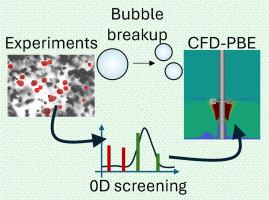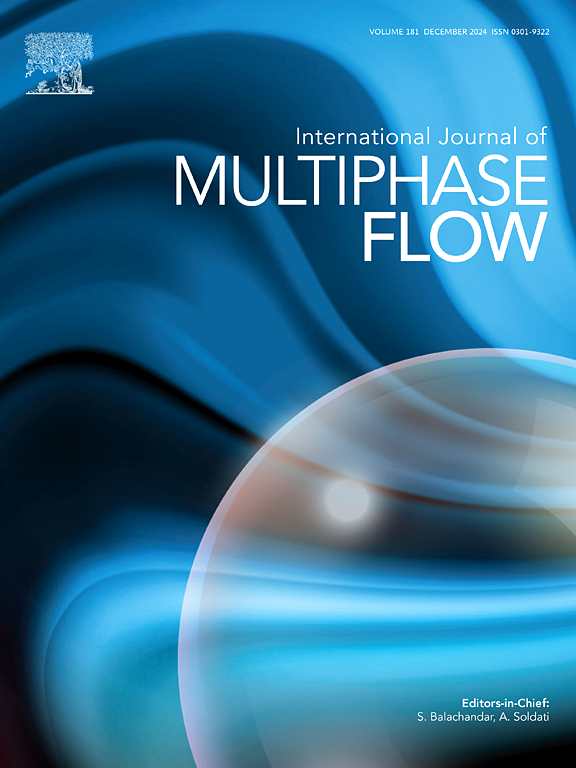Characterization of bubble breakup mechanisms in non-coalescing electrolyte solutions
IF 3.8
2区 工程技术
Q1 MECHANICS
International Journal of Multiphase Flow
Pub Date : 2025-10-02
DOI:10.1016/j.ijmultiphaseflow.2025.105471
引用次数: 0
Abstract
This work presents an integrated experimental and numerical investigation of bubble breakup mechanisms in non-coalescing electrolyte solutions within two geometrically similar gas–liquid stirred tanks of different scales. Bubble size distributions were measured using optical techniques in complete recirculation gas-liquid regime and varying turbulent dissipation rates. The robustness of the image analysis was validated through manual bubble counting.
A lumped parameter population balance equation (PBE) was solved using the quadrature method of moments, with model parameters derived from dedicated CFD simulations. Six breakup kernels, each representing distinct physical mechanisms, were evaluated by comparing predicted and experimental bubble size distributions, moment ratios, and characteristic diameters. The Luo and Svendsen kernel, which models breakup as a function of turbulent eddy energy exceeding surface energy thresholds, showed the best agreement with experimental data. The kernels by Liao et al. and Lehr et al. also performed well, despite being originally validated in coalescing conditions.
A full three-dimensional CFD-based PBE solution further validated the lumped parameter approach, confirming its reliability for preliminary kernel screening. These findings support the use of simplified PBE models for efficient evaluation of breakup mechanisms in gas–liquid stirred tanks under non-coalescing conditions.

非聚结电解质溶液中气泡破裂机制的表征
本文对两个几何形状相似的不同尺度气液搅拌槽内非聚结电解质溶液中的气泡破裂机制进行了综合实验和数值研究。利用光学技术测量了完全再循环气液状态和不同湍流耗散率下的气泡尺寸分布。通过人工气泡计数验证图像分析的鲁棒性。采用矩量正交法求解集总参数总体平衡方程(PBE),模型参数由专用CFD模拟得到。通过比较预测和实验的气泡大小分布、力矩比和特征直径,对代表不同物理机制的6个破裂核进行了评估。Luo和Svendsen核模型将破裂作为湍流涡流能量超过表面能量阈值的函数,与实验数据最吻合。Liao等人和Lehr等人的核也表现良好,尽管最初是在合并条件下验证的。基于cfd的全三维PBE解决方案进一步验证了集总参数方法,证实了其初步核筛选的可靠性。这些发现支持使用简化的PBE模型来有效评估非聚结条件下气液搅拌槽的破裂机制。
本文章由计算机程序翻译,如有差异,请以英文原文为准。
求助全文
约1分钟内获得全文
求助全文
来源期刊
CiteScore
7.30
自引率
10.50%
发文量
244
审稿时长
4 months
期刊介绍:
The International Journal of Multiphase Flow publishes analytical, numerical and experimental articles of lasting interest. The scope of the journal includes all aspects of mass, momentum and energy exchange phenomena among different phases such as occur in disperse flows, gas–liquid and liquid–liquid flows, flows in porous media, boiling, granular flows and others.
The journal publishes full papers, brief communications and conference announcements.

 求助内容:
求助内容: 应助结果提醒方式:
应助结果提醒方式:


